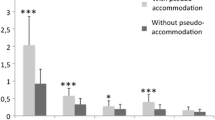Abstract
We studied the benefit of active vision therapy in 910 pseudophakic amblyopic children and young adults suffering from unilateral congenital cataract. It was concluded that noninvasive active vision therapy helps improve visual acuity in the majority of subjects. However, the treatment demands much perseverance from both patient and therapist.
Similar content being viewed by others
References
Diamond GR, Eggers HM. Amblyopia. In: Strabismus and Pediatric Ophthalmology. London, St. Louis: Mosby-Year Book; 1993.
Forest EB. Feedback and the visual process. J Am Optom Assoc 1981;52:717–724.
Vaegan, Taylor D. Critical period for deprivation amblyopia in children. Trans Ophthalmol Soc UK 1979;99:432–439.
Sachsenweger R. Problems of organic lesions in functional amblyopia. In: Arruga A, ed. International strabismus symposium (University of Giessen, 1966). Basel and New York: S. Karger AG, 1968, p. 63.
Ching FC, Parks MM, Friendly DS. Practical management of amblyopia. J Pediatr Opthalmol Strabismus 1986;23:12–16.
Garzia RP. Efficacy of vision therapy in amblyopia: a literature review. Am J Optom Physiol Opt 1987;64:393–404.
Costenbader FD, Albert DG. Conservatism in the management of congenital cataract. Arch Ophthalmol 1957;58:426–430.
Singh D, Verma A. Management of pseudophakic amblyopia in cases of unilateral congenital cataract by active vision therapy. Trop Ophthalmol 2002;2:21–27.
Verma A. Active vision therapy for amblyopia. Trop Ophthalmol 2001;1:10–12.
Cuiffreda KJ. Visual plasticity in human amblyopia. In: Hilfer SR, Sheffield JB, editors. Development of order in the visual system. New York: Springer-Verlag; 1986. p. 211–244.
Caltrider N, Jampolsky A. Overcorrecting minus lens therapy for treatment of intermittent exotropia. Ophthalmology 1983;90:1160–1165.
Hiatt RL, Ringer C, Cope-Troupe C. Miotics vs. glasses in esodeviation. J Pediatr Ophthalmol Strabismus 1979;16:213–217.
Mallet RJF. The use of prisms in the treatment of concomitant strabismus. Ophthalmic Opt 1979;10:793–798.
Beller R, Hoyt CS, Marg E, et al. Good visual function after neonatal surgery for congenital monocular cataract. Am J Ophthalmol 1981;91:559–565.
Helveston EM, Saunders RA, Ellis FD. Unilateral cataract in children. Ophthalmic Surg 1980;11:102–108.
Jacobson SG, Mohindra I, Held R. Development of visual acuity of infants with congenital cataracts. Br J Ophthalmol 1981;65:727–735.
Verma A, Singh D. Active vision therapy for pseudophakic amblyopia. J Cataract Refract Surg 1997;23:1089–1094.
Singh D, Worst J, Singh R, et al. Cataract & IOL. New Delhi: Jaypee Publishers; 1993. pp. 82–97, 189–200.
Singh D, Singh K, Verma A, et al. The Iris-Claw (Artisan) lens. In: Paediatric cataract surgery. Philadelphia: Lippincott Williams & Wilkins, 2005, pp. 150–153.
Singh S.K. Fugo Blade capsulotomy: a new high tech cutting technology. Trop Ophthalmol 2001;1:14–16.
Singh D. Use of the Fugo Blade in complicated cases. J Cataract Refrac Surg 2002;28:573–574.
Flom MC. Issue in the clinical management of binocular anomalies. In: Rosenbloom AA, Morgan MW, editors. Principles and practice of pediatric optometry. Philadelphia: JB Lippencott, 1990.
Birnbaum MH, Koslowe K, Sanet R. Success in amblyopia therapy as a function of age: a literature survey. Am J Optom Physiol Opt 1977;54:259–275.
Vereeken EP, Brant P. Prognosis for vision in amblyopia after the loss of the good eye. Arch Ophthalmol 1984;102:220–224.
Hamed LM, Glaser JS, Schatz NJ. Improvement of vision in the amblyopic eye following visual loss in the contra lateral normal eye: a report of three cases. Binoc Vis Quart 1991;6:97–100.
Oliver M, Neumann R, Chavimovitch Y, et al. Compliance and results of treatment for amblyopia in children more than 8 years old. Am J Ophthalmol 1986;102:340–345.
Neumann R, Oliver M, Gottesmann N, et al. Prognosis for ocular therapy for strabismic and anisometropic amblyopia and for different initial depths of amblyopia. Chibert Int J Ophthalmol 1989;6:22–27.
Author information
Authors and Affiliations
Corresponding author
Additional information
Drs Verma and Singh are from the Dr Daljit Singh Eye Hospital, Amritsar, India.
The authors have stated that they do not have a significant financial interest or other relationship with any product manufacturer or provider of services discussed in this article. The authors also do not discuss the use of off-label products, which includes unlabeled, unapproved, or investigative products or devices.
Rights and permissions
About this article
Cite this article
Verma, A., Singh, D. Rehabilitation and Management of Pseudophakic Amblyopia in Cases of Unilateral Congenital Cataract by Active Vision Therapy. Ann Ophthalmol 39, 284–290 (2007). https://doi.org/10.1007/s12009-007-9002-3
Received:
Accepted:
Published:
Issue Date:
DOI: https://doi.org/10.1007/s12009-007-9002-3




